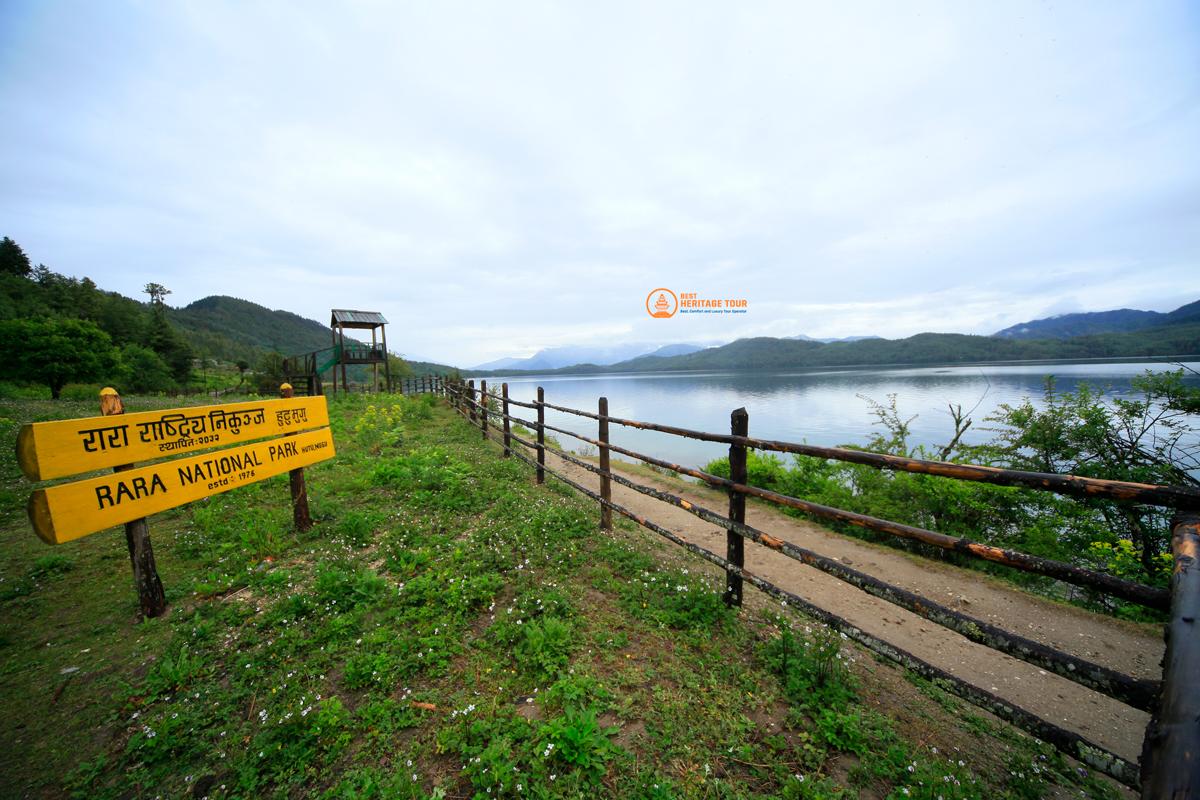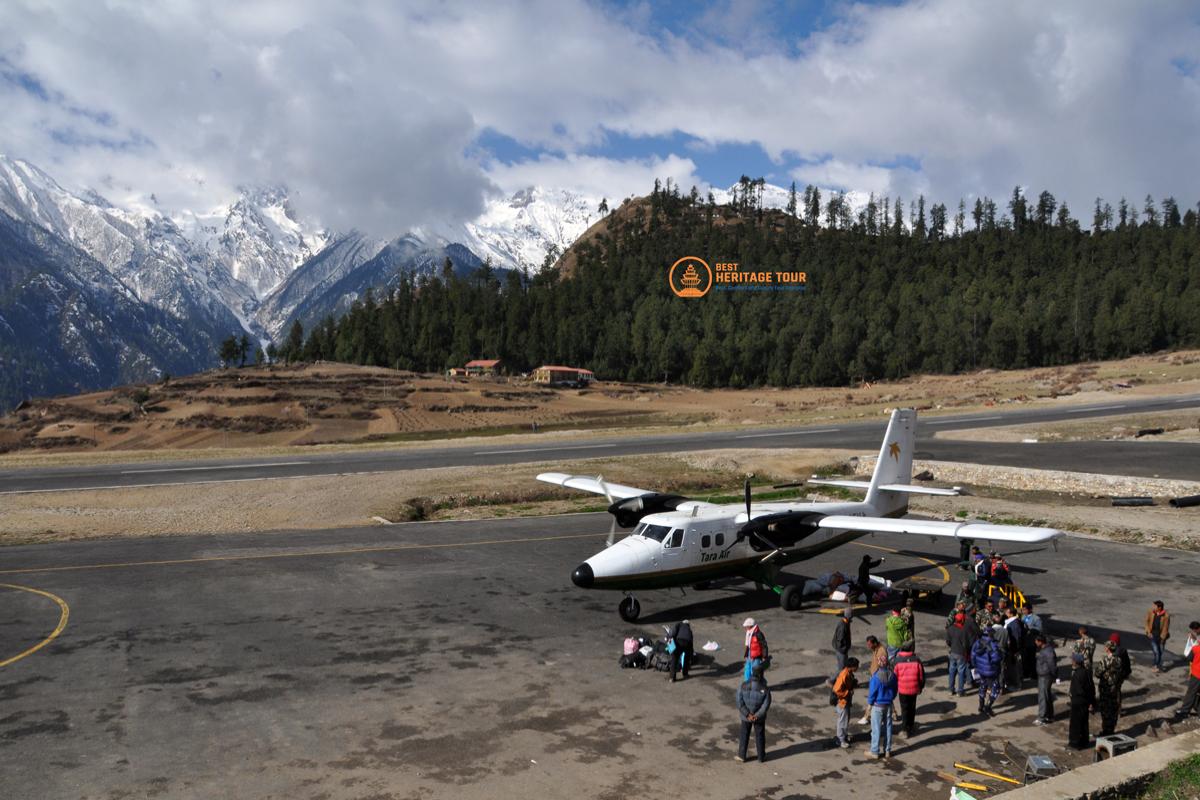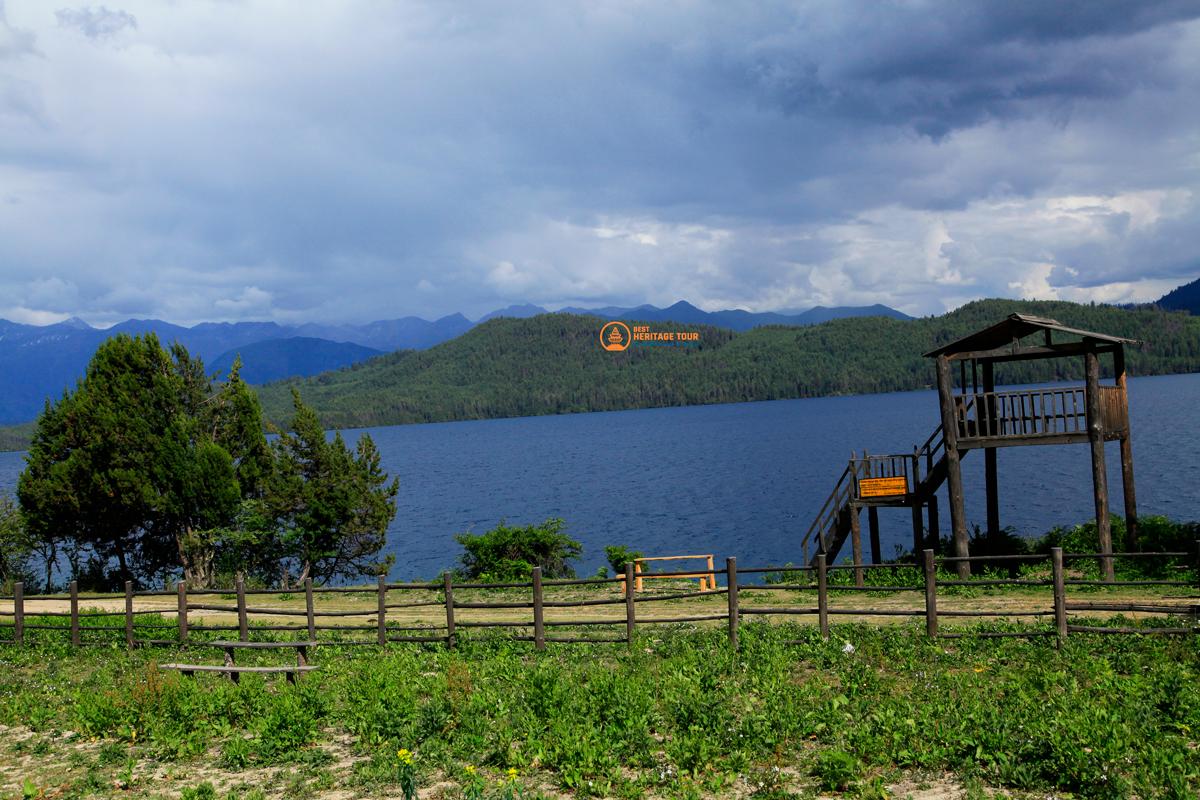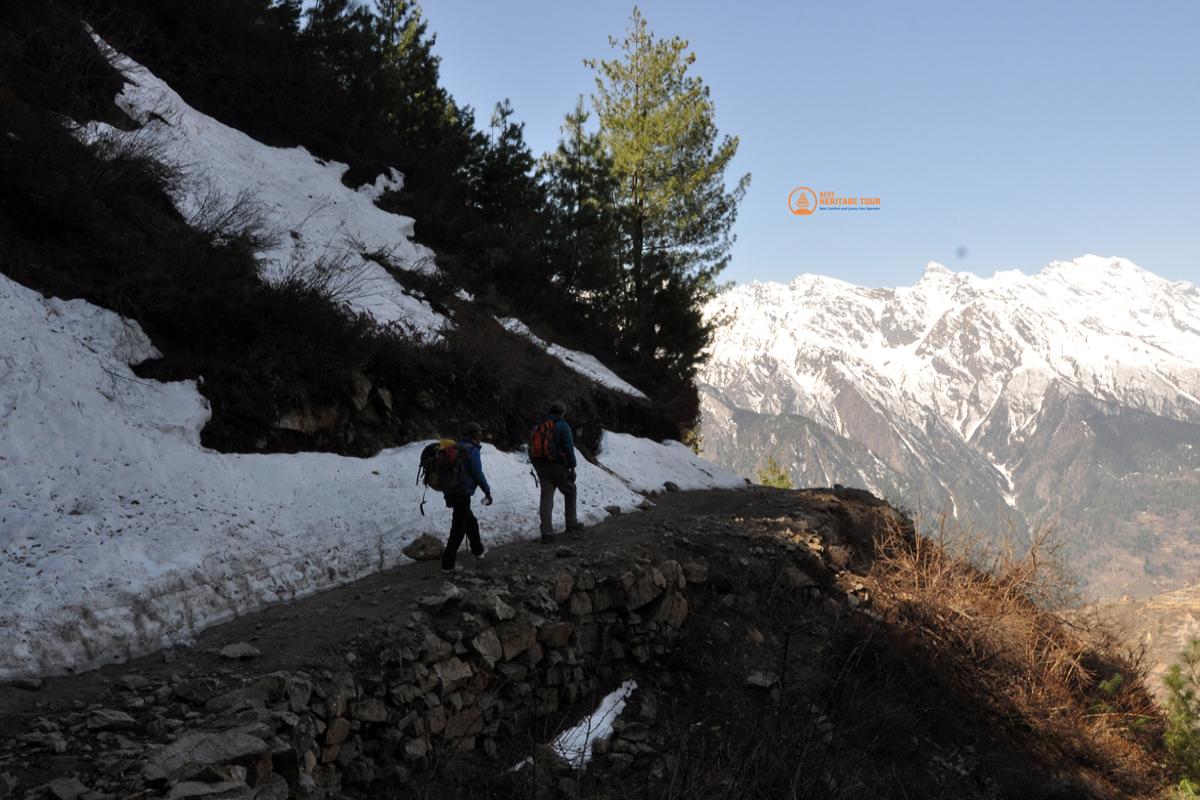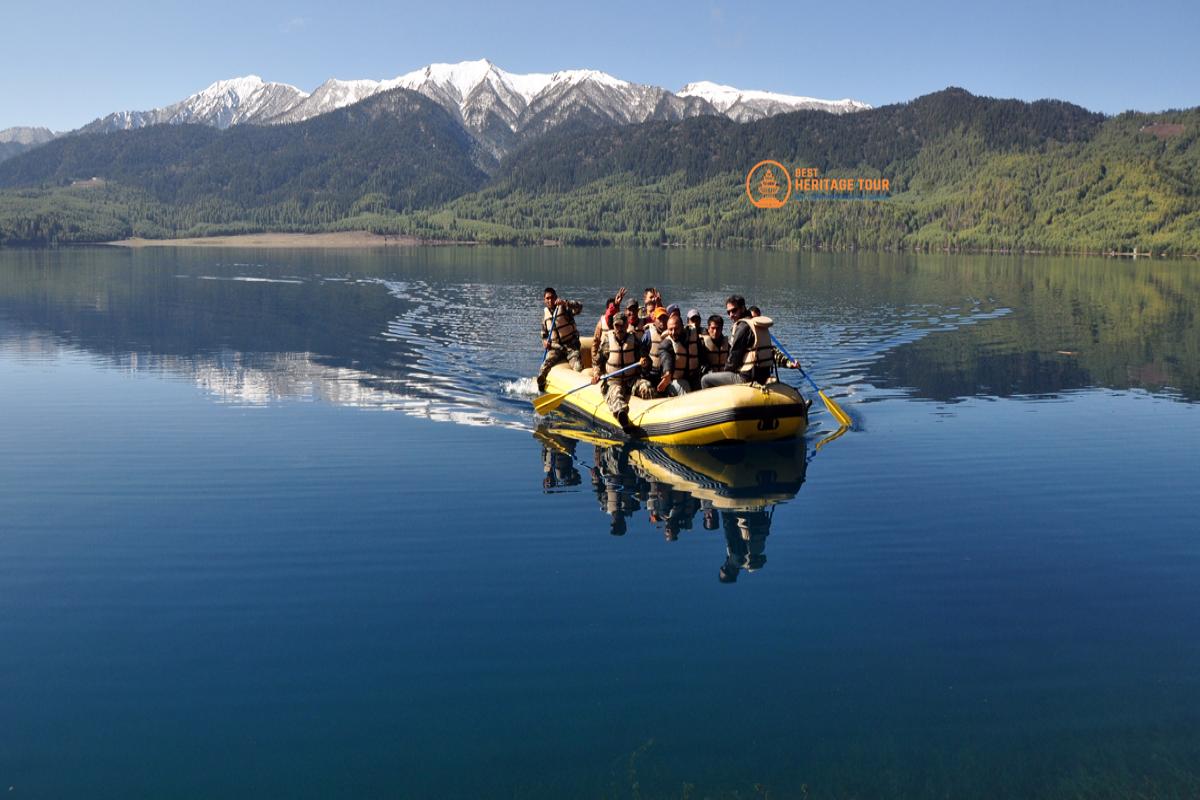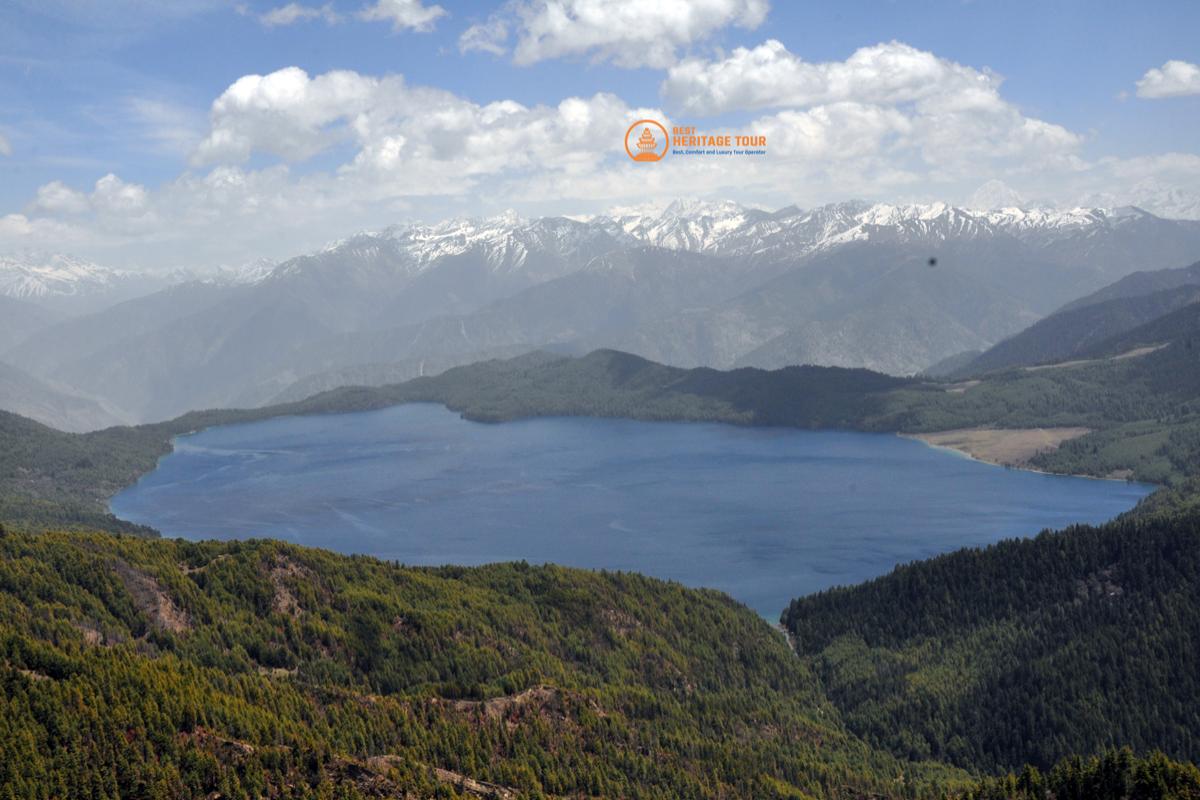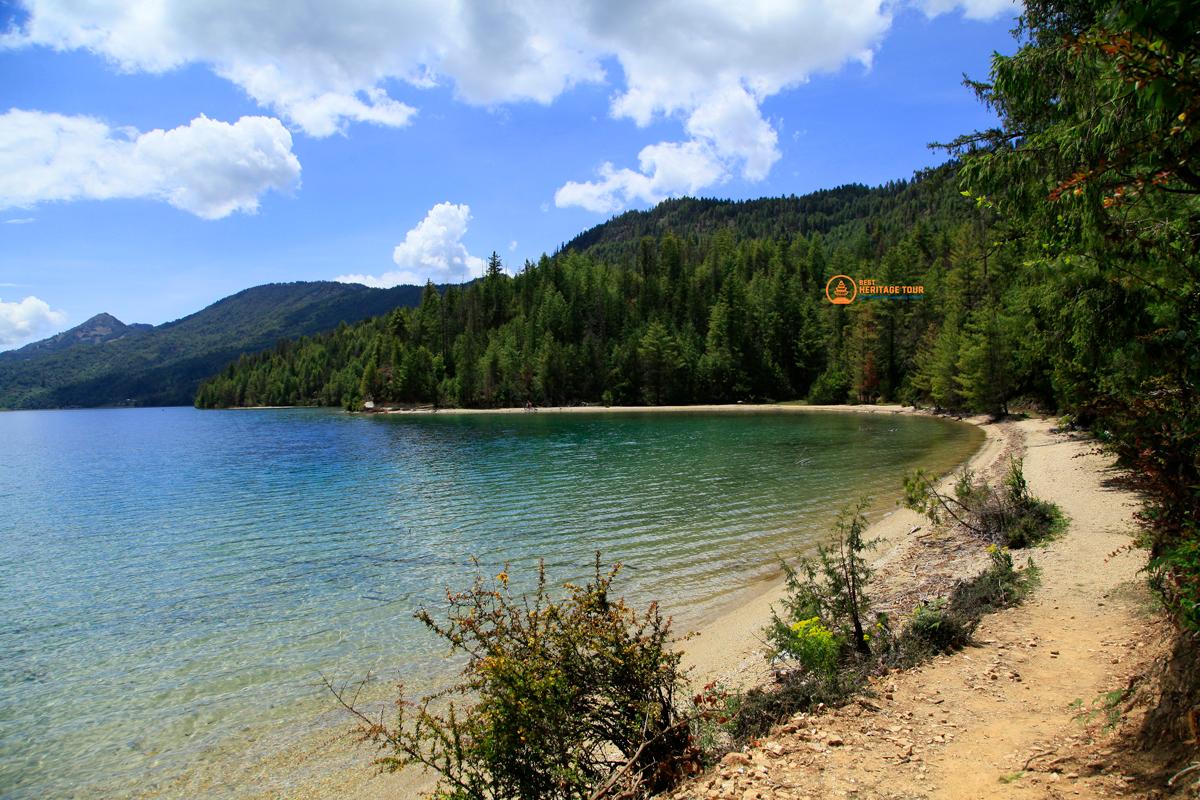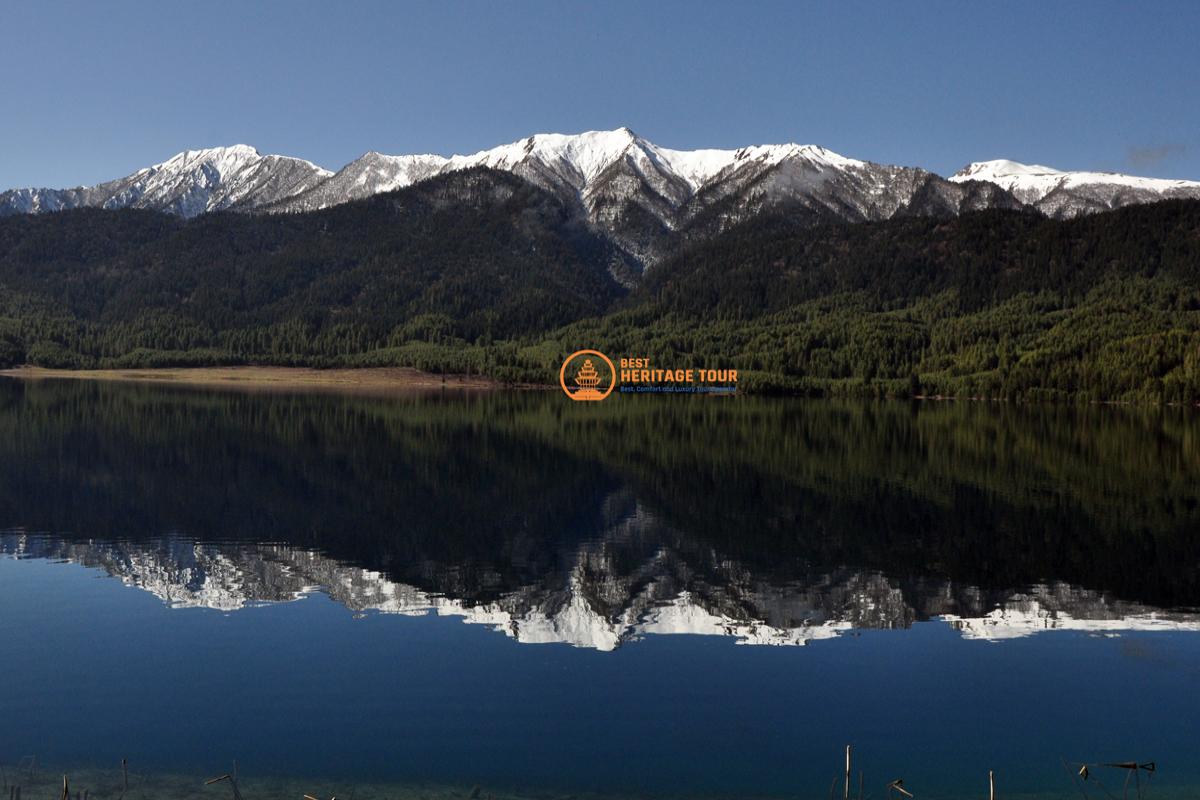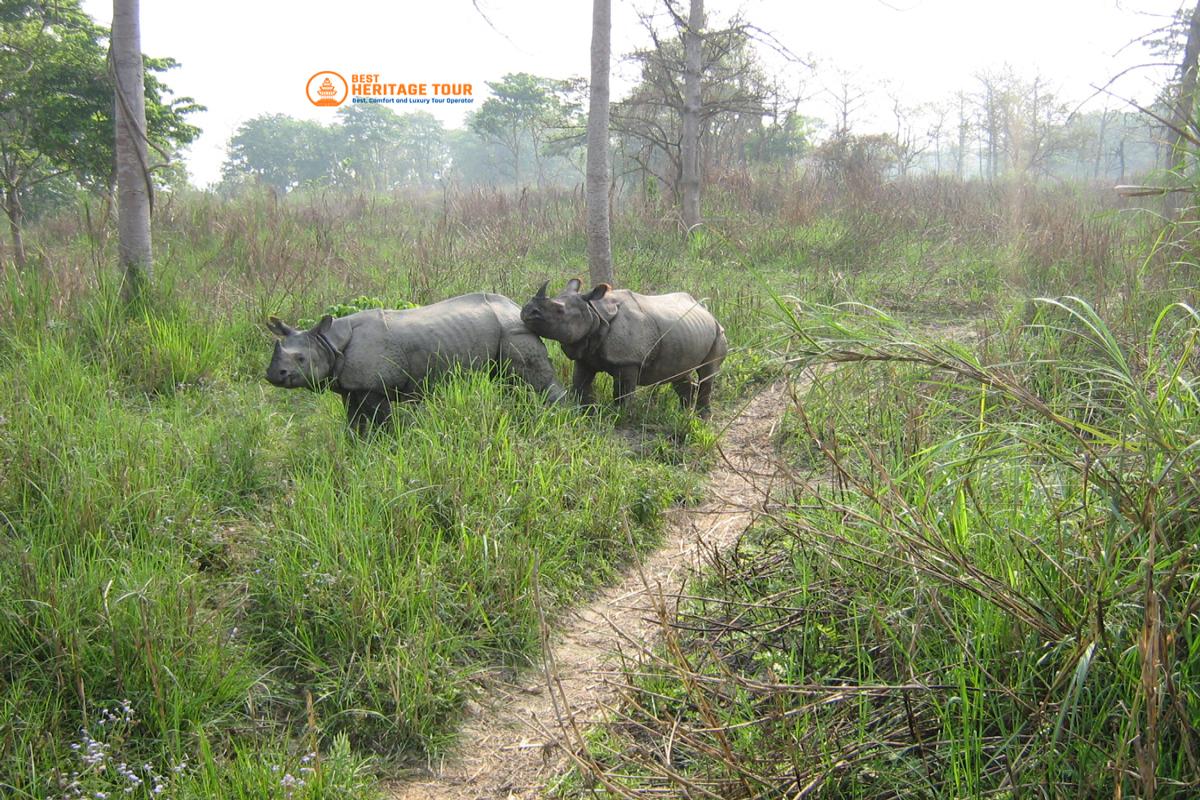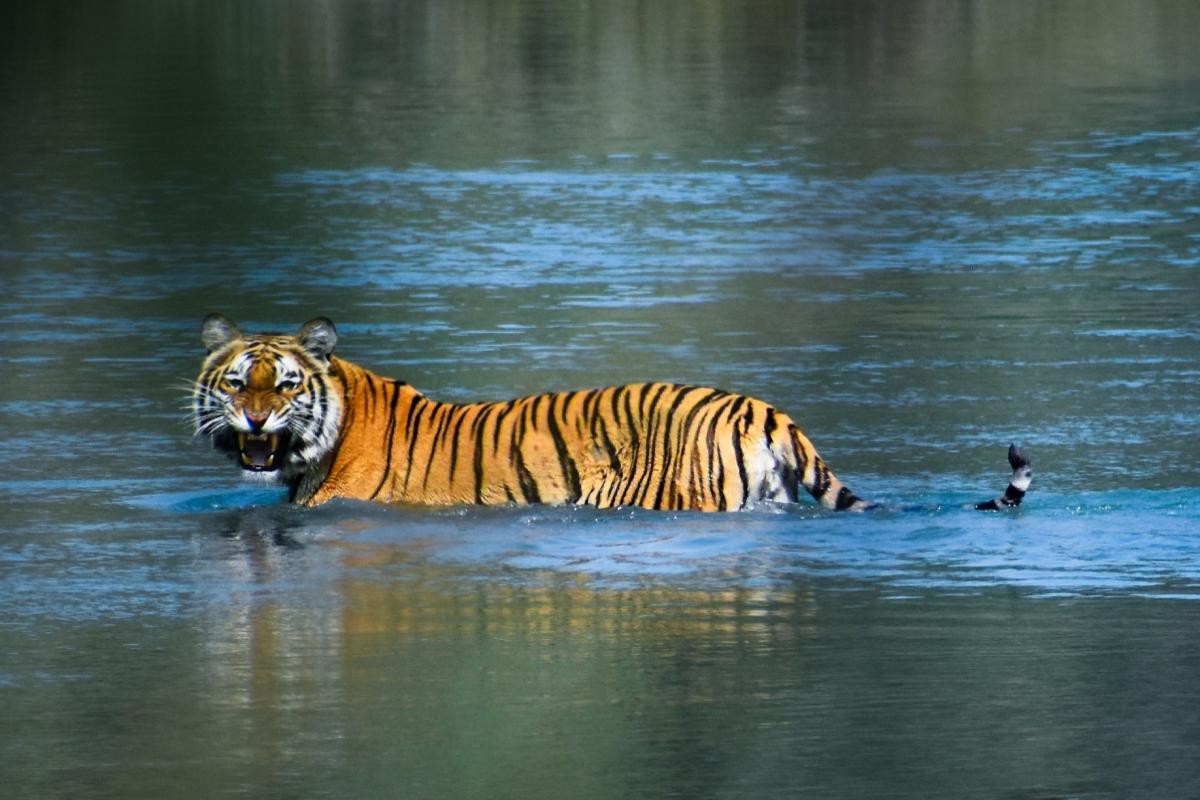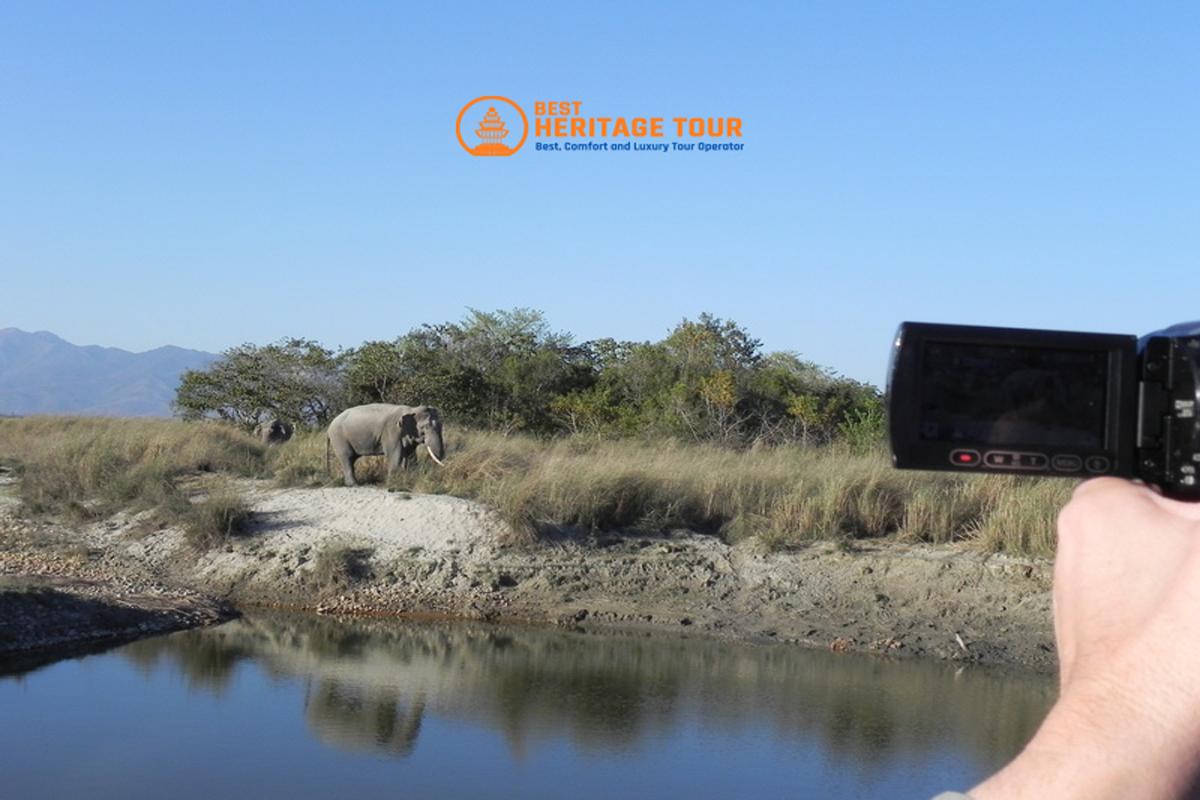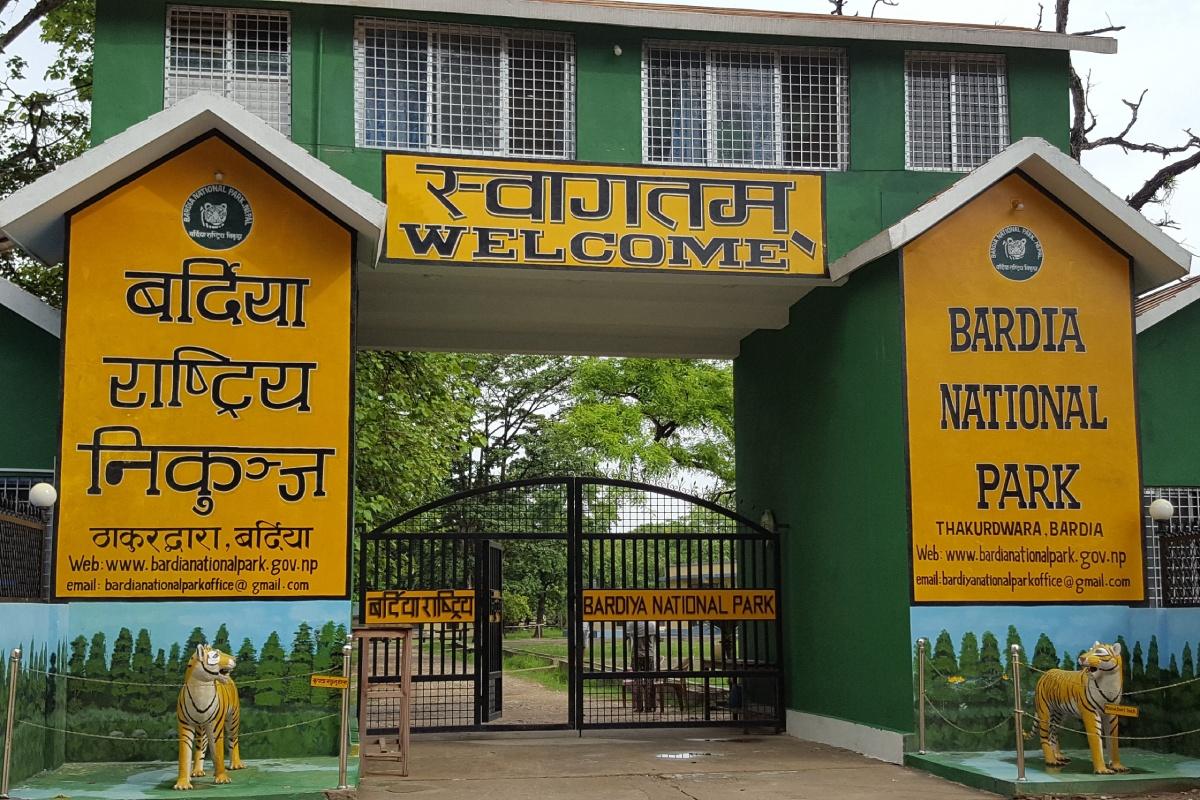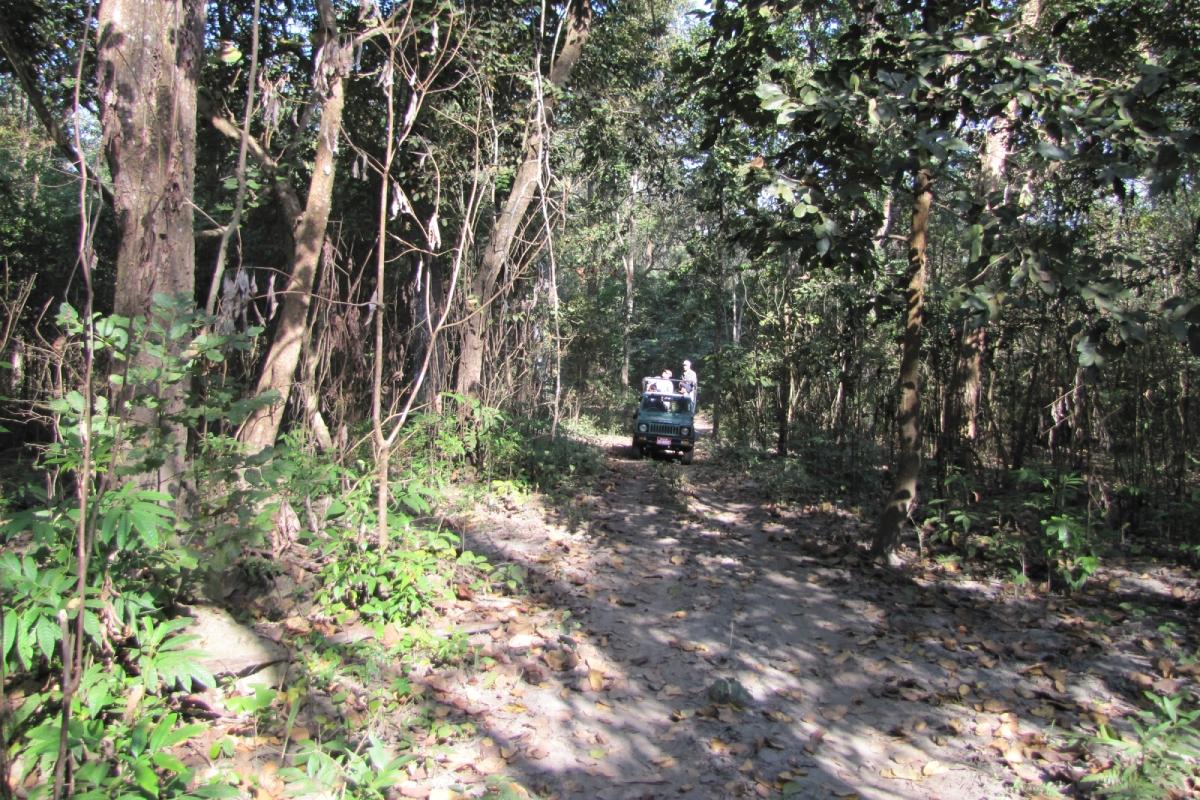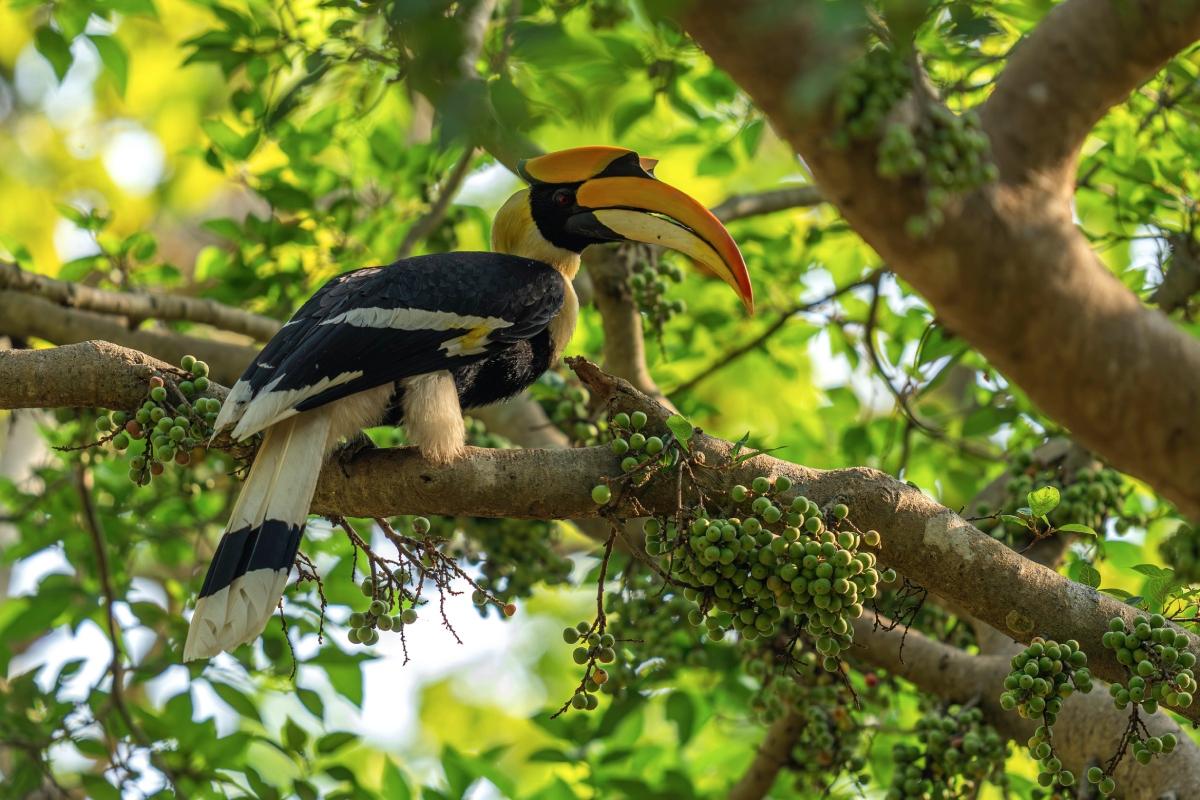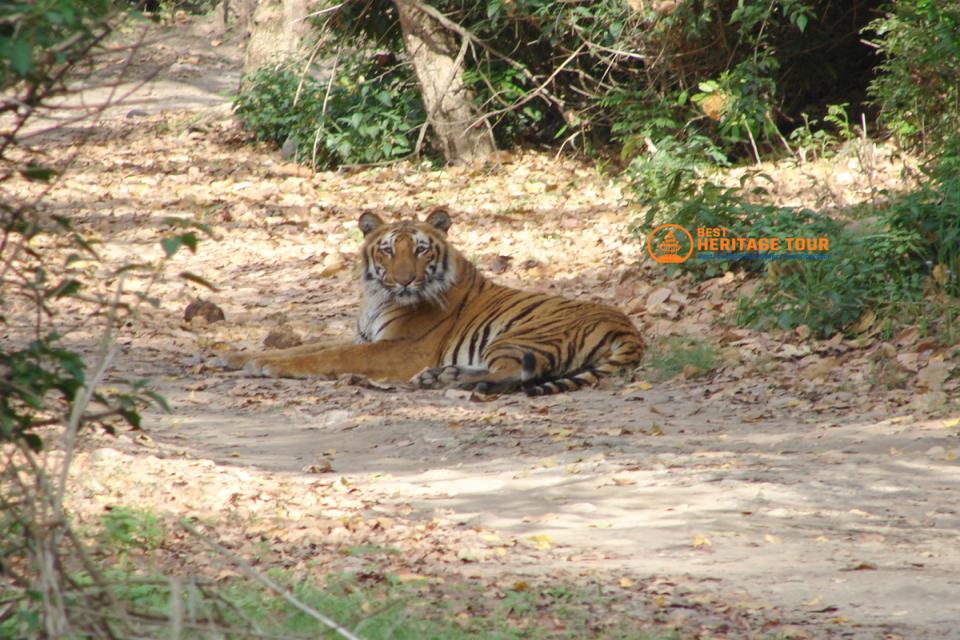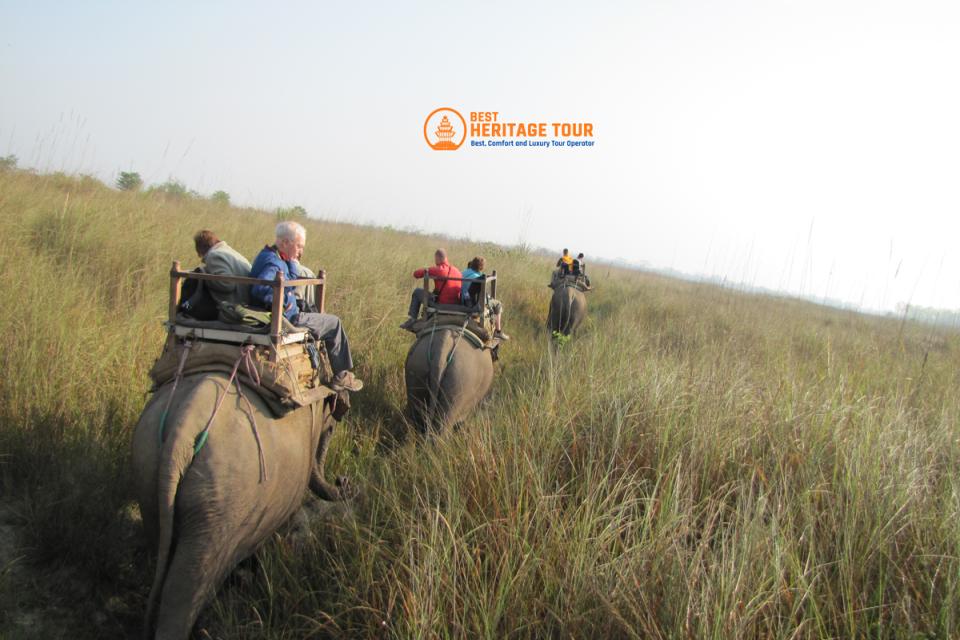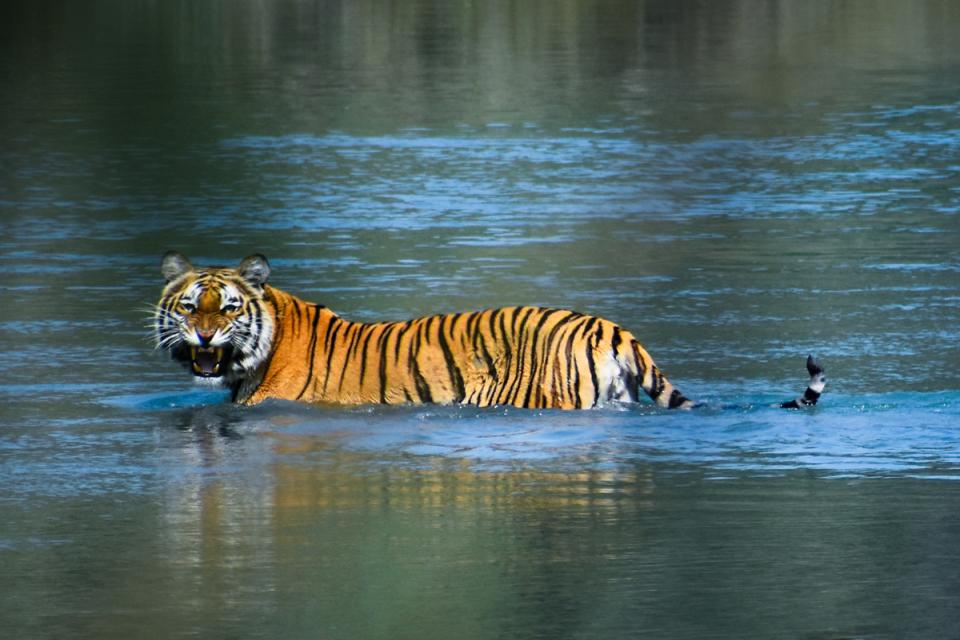Rara Lake & Bardiya Tour - Blend of Himalayan & Wildlife - 7 Days
Insight on Rara Lake & Bardiya Tour
This journey offers a perfect balance of serenity and adventure. Start with thrilling wildlife safaris in Bardiya National Park, where you’ll encounter Bengal tigers, rhinos, and elephants in their natural habitat. Next, immerse yourself in the tranquility of Rara Lake, Nepal's largest, with peaceful lakeside strolls and cultural exchanges in the charming Murma Village. A rewarding hike to Murmatop reveals breathtaking panoramic views of the snow-capped peaks. Whether boating on the crystal-clear lake or trekking through pristine forests, every moment deepens your connection with Nepal’s untouched wilderness and vibrant cultures, crafting a truly unforgettable experience.
Trip at a Glance
Key Highlights
- Journey to the mesmerizing Rara Lake, Nepal's largest, where the turquoise waters shimmer beneath towering snow-capped peaks.
- Embark on thrilling wildlife safaris through the untamed Bardiya National Park, where elusive Bengal tigers, mighty rhinos, and wild elephants roam freely.
- Tread along a remote, untouched path, far from the crowds, offering a deep connection with nature and the rugged wilderness.
- Feast your eyes on breathtaking vistas of the Dhaulagiri and Kanjiroba mountain ranges, with each turn revealing dramatic, pristine landscapes.
- Immerse yourself in the vibrant cultures of the Tharu and Magar communities, discovering their ancient traditions in the heart of Nepal’s wildest corners.
- Conquer challenging terrain, steep climbs, and high-altitude passes, pushing your limits on a trek designed for true adventurers.
- Venture through the hidden Karnali region, a world away from the beaten path, where the raw beauty of Nepal remains untouched.
- Experience the magic of autumn’s crystal-clear skies and spring’s wildflower bloom, as nature unveils its most spectacular colors.
- Begin your expedition in the remote Bardiya region, accessed by rugged roads from Nepalgunj, and rest in simple yet cozy teahouses amidst the wilderness.
Benefit of Bardia-Rara tour with Best Heritage Tour
- Seamless booking process with an informative travel briefing after confirmation.
- Stay connected via email, WhatsApp, Facebook, WeChat, Viber, Skype, or Zoom.
- 24/7 phone support for any assistance at +977-9851149197 / +977-9810043046.
- Secure and easy payment system.
- Free private vehicle transfers to and from the airport.
- Oximeters and medical kits provided for monitoring blood oxygen levels at high altitudes.
- Free sleeping bags and trekking poles available if needed.
- Travel bag provided for porters to carry your gear.
- Free excess baggage storage at our Best Heritage Tour store during the trek.
Trip Overview
Your adventure starts with a flight to Nepalgunj, the entrance to western Nepal’s rugged landscapes, and then continues with a picturesque drive to Bardiya National Park. This remote park is a hidden gem for wildlife enthusiasts, offering an opportunity to explore Nepal’s most biodiverse regions. Known for its significant population of Bengal tigers, one-horned rhinos, and elephants, Bardiya National Park is the perfect place for a thrilling jungle safari. The park is teeming with wildlife, and you can choose to explore it by jeep, on foot, or even on the back of an elephant for a truly immersive experience. A safari through the dense forests and open grasslands of Bardiya will give you the chance to encounter a wide range of animals, from elusive tigers and leopards to deer, wild boar, and a variety of birds. The park's natural beauty and serenity offer an unforgettable wildlife experience. After your time in Bardiya, you’ll travel back to Nepalgunj and board a flight to the remote Rara Lake, located in the Mugu district of western Nepal.
Rara Lake, Nepal's largest lake is a serene haven surrounded by towering snow-capped mountains and dense, untouched forests. Its pristine blue waters reflect the towering peaks, creating one of the most picturesque landscapes in Nepal. Upon arrival, you’ll check into a lakeside lodge and immediately be captivated by the serenity of the place. You can spend the rest of the day walking around the lake’s shores or simply relaxing by the water, taking in the breathtaking views of the surrounding landscape. The peaceful atmosphere of Rara Lake makes it a perfect destination for relaxation and nature lovers.
One of the highlights of your time at Rara Lake is the visit to Murma Village, a quaint and traditional settlement located near the lake. In this charming village, you’ll have the opportunity to interact with the local people, who mostly belong to ethnic communities such as Khas and Tibetan groups. As you stroll through the village, you’ll get a glimpse of their lifestyle, farming practices, and traditions. The peaceful atmosphere of the village, combined with stunning views of the lake and mountains, makes it a great place to learn about local culture and enjoy the tranquility of the region.
From Murma Village, you’ll embark on a rewarding hike to Murmatop, a viewpoint located above the lake. The hike takes you through beautiful forests and offers stunning vistas of Rara Lake, the surrounding mountains, and the expansive landscape below. Once at the top, you’ll be treated to a panoramic view that will leave you in awe of the natural beauty of this region. The sight of the vast blue lake nestled between snow-capped peaks is nothing short of spectacular, making the hike to Murmatop one of the highlights of your trip.
In the coming days, you'll have plenty of time to discover more of Rara Lake and its beautiful surroundings. You can take leisurely walks along the lake’s shores, enjoy boat rides, or simply relax in the peaceful environment. The region’s natural beauty is unmatched, with forests, meadows, and distant peaks all contributing to the serene atmosphere. For those seeking more adventure, there are additional trekking routes and viewpoints that offer spectacular views of the lake and the mountains, allowing you to further immerse yourself in the untouched landscapes of the area.
After thoroughly enjoying Rara Lake’s beauty and peace, you’ll make your way back to Nepalgunj for your flight back to Kathmandu. On the final leg of your journey, you can take some time to reflect on the incredible wildlife experiences in Bardiya and the stunning natural beauty of Rara Lake. Before concluding your tour, you may have the opportunity to enjoy a farewell dinner in Kathmandu, where you can reminisce about your adventure in one of the most remote and beautiful corners of Nepal.
What Makes Bardiya and Rara Lake the Ultimate Nepal Adventure?
1. Thrilling Wildlife Encounters
Experience the excitement of a safari through Bardiya National Park, a wildlife haven where you'll have the chance to spot Bengal tigers, one-horned rhinos, wild elephants, and a variety of other animals in their natural, untamed environment. Whether by jeep, foot, or on the back of an elephant, the park offers an immersive wildlife adventure you won't forget.
2. Tranquil Lakeside Retreat
Escape to the serene beauty of Rara Lake, Nepal’s largest lake, nestled between snow-capped mountains and dense forests. Take peaceful walks along the lake's shores, breathe in the fresh mountain air, and soak in the calming atmosphere. The clear, turquoise waters and panoramic mountain views make this an ideal destination for relaxation and quiet reflection.
3. Cultural Immersion
Discover the vibrant cultures of Nepal’s rural communities. In Bardiya, connect with the Tharu and Magar people, learning about their rich history and traditions. At Murma Village near Rara Lake, interact with the Khas and Tibetan communities, gaining insight into their farming practices, daily lives, and unique cultural heritage.
4. Scenic Treks & Panoramic Views
Embark on a rewarding hike to Murmatop, a viewpoint above Rara Lake, where you'll be treated to breathtaking panoramic views of the lake, surrounding peaks, and lush landscapes. Explore remote trails through pristine forests, offering glimpses of Nepal’s untouched wilderness, and enjoy the sense of accomplishment as you conquer the terrain.
5. Adventure in Remote Wilderness
Challenge yourself with rugged terrain, steep climbs, and high-altitude passes. This tour takes you through some of Nepal's most remote and rugged landscapes, offering a true adventure for trekkers and nature lovers. The isolation and raw beauty of the region provide the perfect backdrop for those seeking a more off-the-beaten-path experience.
6. Unmatched Natural Beauty
Marvel at Nepal’s awe-inspiring natural beauty, from the towering snow-capped peaks of the Dhaulagiri and Kanjiroba mountain ranges to the pristine forests and crystal-clear lakes. Whether you visit during spring's wildflower bloom or autumn’s crisp blue skies, each season brings a new, spectacular view, making this journey a photographer’s paradise and nature lover’s dream.
Itinerary
Upon arrival at Tribhuvan International Airport, you will be welcomed by our representative and transferred to your hotel in Kathmandu. After check-in, you have the rest of the day to relax. If you have energy, you can explore Thamel, Kathmandu's bustling district, known for its shops, restaurants, and cultural sites. Alternatively, you can visit Garden of Dreams for a peaceful walk or explore nearby markets.
After breakfast, you’ll head to Tribhuvan International Airport for your flight to Nepalgunj, where you will experience a scenic view of the Himalayas and Terai plains. Upon arrival in Nepalgunj, you’ll take a 3-hour drive to Bardiya National Park, one of the most remote and wildlife-rich regions of Nepal. The drive will take you through rural landscapes and lush fields, giving you a first taste of the Terai's natural beauty.
Once you reach the park, you'll check in at your lodge and enjoy an introductory briefing. In the evening, you can take part in nature walks around the lodge area or relax by the campfire. In the evening, you will have the opportunity to witness a Tharu cultural dance performance. This traditional dance, performed by the local Tharu community, involves rhythmic movements and drumming and is a unique insight into the region's indigenous traditions. Enjoy a traditional Tharu meal such as dal-bhat (lentils and rice), roti (flatbread), tarkari (vegetable curry), and local specialties like wild boar curry if available.
After breakfast, you’ll embark on an exciting jungle safari in Bardiya National Park. You’ll have options to explore the park on elephant-back, jeep safari, or a walking safari with a naturalist guide. Early mornings are the best time to spot wildlife as the animals are more active. You can expect to spot Bengal tigers, one-horned rhinos, elephants, leopards, and wild boars. Bardiya is also a haven for birdwatchers, with over 350 bird species. You might spot the great hornbill, sarus cranes, and eagles during your safari.
After the safari, return to the lodge for lunch, featuring local dishes like momo (dumplings), gundruk (fermented leafy vegetable), and mashalu (spiced mashed potatoes). In the afternoon, take a nature walk or visit a nearby Tharu village. The village offers a glimpse of rural life, where you can interact with local farmers and learn about their traditions. You may also observe traditional mud houses, agriculture practices, and local handicrafts. After a day of exploration, enjoy an evening sunset walk along the park’s river or a relaxing time in the lodge.
After breakfast, drive back to Nepalgunj. During the drive, enjoy scenic views of rural villages, forests, and agricultural lands. After arriving in Nepalgunj, board your flight to Rara, located in the Mugu district of western Nepal. This flight offers incredible views of the Himalayas and the stunning Rara Lake region. Upon arrival, you’ll be transferred to a lakeside lodge near Rara Lake. The tranquil lake surrounded by snow-capped peaks provides a serene environment to unwind and enjoy nature. After check-in, enjoy the peace and beauty of Rara Lake. You can take a short lakeside walk, absorb the stunning views, or relax by the lake.
After breakfast, enjoy a peaceful boat ride on the serene waters of Rara Lake. The ride takes you through the lake’s crystal-clear waters, and you’ll be surrounded by snow-capped mountains and forests. It's a great opportunity to enjoy the serene atmosphere of this remote location. After your boat ride, you’ll visit Murma Village, located near the lake. This village is known for its traditional Khas and Tibetan culture. You can interact with the locals, observe their handicrafts, and learn about agriculture and livelihoods in this remote region. The locals are friendly and eager to share their traditions with visitors. Enjoy a meal in the village, featuring Thukpa (noodle soup), Momo (dumplings), and Sel Roti (rice donuts), traditional dishes of the region.
In the afternoon, take a 2-3 hour hike to Murmatop, a scenic viewpoint located above the lake. The hike takes you through pine forests, meadows, and remote villages, with spectacular views at the top, offering panoramic vistas of Rara Lake and the surrounding mountains. Return to the lodge and relax. You can enjoy a peaceful sunset by the lake or a quiet walk around the area.
Start your day with a leisurely walk along the shores of Rara Lake. The calm atmosphere, coupled with breathtaking mountain views, provides the perfect environment for relaxation and observation. For those interested in further exploration, you can take an additional hike to other viewpoints in the area. The Himalayan views and lake vistas are stunning from all angles.
You can also spend the morning bird watching or looking out for other local wildlife like Himalayan tahr, blue sheep, and various species of wildfowl around the lake. Enjoy a relaxing afternoon. If you prefer, you can take another boat ride or visit more local villages to observe traditional farming practices and learn about local customs. You can also enjoy quiet moments by the lakeside or visit nearby forest areas for exploration. Enjoy a traditional dinner at the lodge, perhaps sampling dishes like Chhaang (millet beer), Dal Bhat, and chatamari (Nepali-style pancake).
After breakfast, fly back from Rara to Nepalgunj. The scenic flight provides one last chance to view the Himalayan landscape and Rara Lake from the air. Upon arrival in Nepalgunj, catch your return flight to Kathmandu.Once you land in Kathmandu, you will be transferred to your hotel in for check-in and relaxation.
What is included?
- Pickup and drop-off between the airport and hotel in Kathmandu
- Flight from Kathmandu-Nepalgunj-Rara, and Rara-Nepalgunj-Kathmandu, including airport taxes
- Private jeep transfers between Nepalgunj, Bardiya, and Talcha-Milichaur (Rara Airport)
- Standard hotel lodging in Kathmandu, Bardiya, and Rara
- All type of meals i.e. Breakfast, Lunch, Dinner
- All National Park Entry Fees: Bardiya National Park (BNP) and Rara National Park (RNP)
- An experienced English speaking Licensed trekking guide to ensure a safe and informative journey
- Enjoy a boat ride on the serene Rara Lake
- Traditional dinner to greet you and bid farewell
What is not included?
- International Airfare: Flights to and from Nepal, including airport departure taxes
- Safari activities in Bardiya National Park (BNP) are not included
- Extra night accommodations in Kathmandu, if necessary
- Personal expenses such as snacks, souvenirs, laundry, or additional services
- Costs for horse riding in Rara lake
- Personal Trekking Gear
- Travel Insurance
- Additional Costs Due to Natural Disasters: Extra expenses due to unforeseen circumstances like flight cancellations or natural disasters etc
- Any other costs not mentioned in the Itinerary or Include section
- All government taxes 13%, SSF, and 10% service charges
Route Map
Equipment
Clothing
-
Comfortable hiking shoes/boots (preferably waterproof)
-
Lightweight, moisture-wicking clothing
-
Warm layers
-
Rain jacket or poncho
-
Thermal wear
-
Quick-dry towel (for boat rides or rainy weather)
Sun protection
-
Hat or cap
-
Sunglasses (with UV protection)
-
Sunscreen
Safari & Trekking Gear
-
Binoculars
-
Camera (with extra memory cards and batteries)
-
Daypack
-
Water bottle
-
Insect repellent (mosquitoes are common in the Terai and near water)
-
Small flashlight/headlamp (with extra batteries)
For Rara Lake & Trekking
-
Trekking poles
-
Warm gloves and hat
-
Gaiters
-
Camera with a zoom lens (for capturing wildlife from a distance)
-
Snacks/energy bars (for longer hikes or boat rides)
Personal Items
-
Personal hygiene products: toothbrush, toothpaste, hand sanitizer, etc.
-
Medications and first aid kit
-
Passport and it’s Hardcopy
-
Travel insurance
Trip Info
Best Season for Bardiya- Rara Tour
The ideal seasons to visit Bardiya and Rara Lake are autumn (October to November) and spring (March to May), when the weather is most favorable for travel and outdoor activities. Here's why:
1. Autumn (October - November)
-
Weather: The climate is typically clear, crisp, and pleasant, with mild temperatures, creating perfect conditions for outdoor activities like jungle safaris and hiking.
-
Wildlife Viewing: This is one of the best times for wildlife spotting in Bardiya National Park, as animals are more active after the monsoon season, and vegetation is less dense.
-
Scenic Beauty: The landscape is lush and green post-monsoon, and the views around Rara Lake and the Himalayas are particularly breathtaking due to the clear skies.
-
Festivals: This season coincides with some of Nepal's biggest festivals, like Dashain and Tihar, which adds a cultural element to the experience.
2. Spring (March - May):
-
Weather: Spring offers mild to warm weather, making it another great time for trekking, jungle safaris, and exploring Rara Lake. Temperatures are comfortable, but it doesn’t get too hot.
-
Wildlife Viewing: This is another excellent period for spotting wildlife in Bardiya, as the weather is still dry and animals are often seen around water sources.
-
Flower Blooms: In spring, the region's flora, including alpine flowers and rhododendrons, is in full bloom, adding vibrant colors to the landscape.
-
Clear Views: The skies are generally clear, and the Himalayan vistas are spectacular, especially around Rara Lake.
3. Other Considerations:
-
Winter (December - February): While still a good time to visit, it can be quite cold, especially in the Rara Lake area, which sits at a high altitude. The cold might restrict some activities like boat rides or longer treks.
-
Monsoon (June - September): The monsoon season brings heavy rainfall, making travel to places like Bardiya and Rara Lake more challenging due to muddy roads, slippery trails, and limited wildlife sightings. It's best to avoid this season for outdoor activities.
Permits Required for Rara and Bardiya National Park Tour
To join the Rara and Bardiya National Park Tour, a few permits are required to ensure entry into protected areas and the smooth operation of your trip. Best Heritage Tour will handle all necessary permit arrangements on your behalf.
1. Rara National Park Entry Permit: Required for entering Rara National Park, home to Rara Lake and diverse wildlife. The fee supports park conservation and local development.
2. Bardiya National Park Entry Permit: Needed to access Bardiya National Park, famous for tigers, rhinos, elephants, and rich birdlife. The fee aids conservation and eco-tourism efforts.
All permits will be arranged by Best Heritage Tour before the trip begins. Please carry at least two passport-sized photos and a copy of your passport for the permit process.
Accommodation & Meals
Throughout the Rara and Bardiya National Park Tour, you’ll stay in comfortable hotels, jungle lodges, and local guesthouses, offering a blend of comfort and authenticity. In Bardiya, jungle lodges provide cozy rooms with attached bathrooms and a serene natural setting. Around Rara Lake, accommodations are simpler but warm and welcoming, run by local families.
Meals are typically Nepali and continental, freshly prepared with locally sourced ingredients. During the trip, you’ll enjoy breakfast, lunch, and dinner, with options to taste regional delicacies such as dal bhat and local fish dishes. Vegetarian and vegan options are also available upon request.
Physical Fitness
The Rara and Bardiya National Park Tour is a moderately easy adventure, suitable for travelers of all ages with average fitness levels. Most of the journey involves short hikes, wildlife safaris, and scenic drives, rather than strenuous trekking. A few walks around Rara Lake and Murma Village may include gentle uphill trails, so basic stamina and comfort with outdoor activities are recommended.
No prior trekking experience is required - just a positive attitude and readiness to explore nature. Staying hydrated, walking regularly before your trip, and maintaining a light level of physical activity will ensure you enjoy this journey comfortably.
Health and Safety
Your health and safety are our top priorities throughout the Rara and Bardiya National Park Tour. Both destinations are at moderate altitudes, so there is no major risk of altitude sickness, but staying hydrated and taking it easy during hikes around Rara Lake is advised.
In Bardiya National Park, all jungle safaris are led by experienced local guides and naturalists who ensure safe wildlife viewing and strict adherence to park regulations. Follow their instructions carefully, especially during encounters with wild animals. We recommend carrying a personal first-aid kit, insect repellent, sunscreen, and any necessary prescription medications.
Travel Insurance
Travel insurance is highly recommended for the Rara and Bardiya National Park Tour to ensure a safe and worry-free journey. Your insurance should cover medical emergencies, trip cancellations, delays, and lost or damaged luggage. While this tour doesn’t involve extreme altitudes or technical trekking, some areas are remote and have limited medical facilities, making coverage for medical evacuation important.
Visa for Nepal
All foreign travelers (except Indian citizens) must obtain a Nepal Tourist Visa to join the Rara and Bardiya National Park Tour. Visas are easily available on arrival at Tribhuvan International Airport in Kathmandu or at designated land border entry points. The process is simple - fill out a short form, provide a passport-sized photo, and pay the visa fee for 15, 30, or 90 days, depending on your travel duration. Your passport must be valid for at least six months from your date of entry.
Booking and Payments
To book the Rara Lake & Bardiya Tour, simply contact Best Heritage Tour via their website or customer service for availability and detailed information. A 10% deposit is required at the time of booking to secure your spot, with the remaining balance due before the tour starts. Payments can be made through secure methods such as bank transfer, credit card, or online platforms. For cancellations or changes, Best Heritage Tour provides clear guidelines, with partial refunds available depending on the timing. Be sure to review our Terms & Conditions to ensure a smooth process.
Last- Minute Booking
Though we recommend booking in advance to secure your spot on the tour, Best Heritage Tour accepts the last- minute bookings. For these bookings, full payment (100% of the tour price) is required at least 24 hours prior to departure. Please note that while we strive to offer flexibility, we cannot be responsible for any delays or unforeseen issues such as weather conditions or unavailable accommodations.
For last- minute bookings or inquiries, contact us at +977- 9851149197 / +977- 9810043046 or email us at info@bestheritagetour.com / bestheritagetour@gmail.com
Trip Extensions
For those who are willing to extend their trip and stay in Nepal, Best Heritaeg Tour have many packages to offer them. So, do check our Official Website. If you want to extend your trip and confused among so many packages, Best Heritage Tour suggest some packages related to Rara Lake and Bardiya Tour. You can visit Lumbini or even can choose Bardiya Safari. You can also opt for pure Rara Lake Tour. We have so many to offer- choice is yours to choose and we are there to organize that tour to you.
Review
Best sunset view of my life
Thank you Best Heritage Tour for making Rara Bardiya tour possible for me because of which I got to experience Nepal nature and culture both in single tour. What a...
View DetailWonderful tour and best service
I recently had an amazing experience on the Rara Bardiya Tour with Best Heritage Tour and I do not back out to recommend it to other. Every part of the trip was special and there...
View DetailMemorable tour in Nepal with my sisters
We sisters just got back from the Rara Bradiya tour and let me tell you that it was an absolutely amazing tour of ours together. We enjoyed each and every moments during the tour...
View DetailLovely time in Nepal
The Rara and Bardiya tour with BHT was a wonderful experience. The tour offered me wildlife sighting in Bardiya, crystal clear deep blue water in Rara Lake and the breath-taking...
View DetailA worthy Tour in nature
Rara Lake- Bardiya tour was a perfect tour for me. From the beautiful mountains and high altitude lake to the dense forest and rare wildlife, this tour covered everything that a...
View DetailBest Cultural and Nature Exploration Tour
What a great adventure of my life.From the Tharu culture to the Karnali region culture, this tour was full of cultural and nature exploration. The Tharu culture in the Bardiya was...
View DetailFAQ's
While Nepali is the primary language, most staff members in lodges speak English, and some may even speak other languages. Communication should not be an issue for international tourists.
It’s advisable to be up-to-date on routine vaccinations, including hepatitis A and typhoid. Talk to your doctor about the vaccinations you need for Nepal.
The majority of international flights arrive at Tribhuvan International Airport, which is located in Kathmandu. From this location, travelers can connect to Lukla to commence their trekking journey.
You typically need a valid passport, a completed visa application form, and a passport-sized photo. Payment can be made in cash or via card at the airport.
Yes, tourist visas are eligible for extension at the Department of Immigration located in Kathmandu. Ensure you have a valid reason and required documents for the extension.
During the Mardi Himal Short Trek, accommodation is in local tea houses or lodges. These are basic but comfortable, offering simple rooms with shared bathroom facilities. Most tea houses provide a bed with blankets, and you may also need to bring a sleeping bag for added warmth, especially at higher altitudes. The Best Heritage Tour ensures you experience authentic local hospitality during the trek.
If you wish to extend your stay in Nepal beyond your visa’s initial duration, you can do so by applying at the Department of Immigration in Kathmandu. Extensions are available for a maximum of 30 days, and it’s recommended to apply before your current visa expires. Best Heritage Tour can help you with the extension process if required during your Australian Camp Trek.
The best times for Bardiya & Rara Lake Tour are during autumn (October to November) and spring (March to May). These seasons offer clear skies, mild weather, and excellent conditions for wildlife viewing and trekking.
Bardiya National Park is home to Bengal tigers, one-horned rhinos, wild elephants, leopards, deer, wild boar, and over 350 bird species, including the great hornbill and sarus cranes.
The tour includes some challenging terrain with steep climbs and high-altitude passes. It is designed for adventurers with a good level of fitness who are comfortable with hiking in rugged conditions.
The hike to Murmatop takes approximately 2-3 hours and offers spectacular views of Rara Lake and the surrounding snow-capped mountains.
Yes, you’ll have the chance to interact with local communities such as the Tharu, Magar, Khas, and Tibetan people, learning about their traditions, farming practices, and cultural heritage.
The tour includes stays in standard hotels in Kathmandu, lodges near Bardiya National Park, and lakeside accommodations near Rara Lake. All accommodations are simple yet comfortable.
While the tour is designed for adventurous travelers, families with children who are accustomed to outdoor activities and nature exploration can also enjoy it. However, some parts of the trek might be challenging for young children.
You’ll need comfortable hiking shoes, a rain jacket, trekking poles, and sun protection. For safaris, binoculars and a camera are recommended. We also provide sleeping bags, down jackets, and a travel bag for porters.
Yes, we provide medical kits and oximeters to monitor blood oxygen levels at high altitudes. Our guides are trained to assist with any health concerns, and emergency evacuation is available if necessary.
You will fly to Nepalgunj, then drive to Bardiya National Park. After exploring Bardiya, you will fly to Rara Lake from Nepalgunj, which offers incredible views of the region.
At Rara Lake, you can enjoy boat rides, scenic lakeside walks, cultural village visits, wildlife watching, and hiking to viewpoints such as Murmatop for panoramic views of the lake and surrounding mountains.
The tour includes airport transfers, accommodation, meals (breakfast, lunch, and dinner), domestic flights, private transport, national park entry fees, a licensed guide, and a boat ride on Rara Lake. Optional activities like the jungle safari in Bardiya are not included in the tour price.
Autumn offers crisp, clear, and pleasant weather with mild temperatures. It’s an excellent time for outdoor activities like jungle safaris and hiking. The landscape is lush and green, especially after the monsoon season, and the Himalayan views are particularly stunning.
Spring provides mild to warm weather, perfect for trekking and exploring. The temperatures are comfortable, ranging from 15°C to 25°C (59°F to 77°F) in lower regions, but higher altitudes will be cooler.
Yes, but it can be quite cold, especially around Rara Lake, which sits at a high altitude. While you can still visit, certain activities like boat rides may be restricted due to freezing temperatures.
The monsoon season brings heavy rainfall, which can make travel challenging. Roads may become slippery, and trails may be muddy, which could limit outdoor activities. It’s best to avoid this season for trekking and wildlife safaris.
In Bardiya, the temperatures can range from 20°C to 30°C (68°F to 86°F) during the day, while it can drop to around 10°C to 15°C (50°F to 59°F) at night.
Near Rara Lake, temperatures are cooler due to the high altitude, ranging from 10°C to 18°C (50°F to 64°F) during the day. Night temperatures can drop to 0°C to 5°C (32°F to 41°F), especially in the colder months.
Wildlife is generally more active after the monsoon season, especially during autumn. The clearer skies and less dense vegetation in the cooler months make wildlife spotting easier.
Yes, the weather in spring and autumn is favorable for outdoor activities such as trekking, boating, and hiking. The clear skies, moderate temperatures, and spectacular scenery make these seasons ideal for exploring Rara Lake and its surroundings.
Rara Lake sits at a higher altitude (approximately 2,980 meters or 9,780 feet), which means it experiences cooler temperatures, especially at night. It can get quite chilly, so it's essential to carry warm layers.
Yes, you should bring lightweight, moisture-wicking clothing for the daytime and warm layers for the cooler evenings, especially in Rara Lake. For Bardiya, lightweight and breathable clothing is recommended for safaris. A rain jacket, thermal wear, and a sun hat are also advisable.
The flight from Nepalgunj to Rara Lake offers incredible views of the Himalayan ranges. The temperatures will be warm at lower altitudes but will cool as you approach Rara Lake, where you’ll feel a noticeable drop in temperature due to the high altitude.
You can arrive in Nepal by flying into Tribhuvan International Airport in Kathmandu (KTM), the capital of Nepal. From there, you will take a domestic flight to Nepalgunj and then a connecting flight to Rara Lake or travel by road to Bardiya National Park.
Most nationalities can obtain a tourist visa on arrival at Tribhuvan International Airport. You will need a valid passport, a passport-sized photo, and the appropriate visa fee (ranging from USD 30 for 15 days to USD 100 for 90 days).
Yes, you can apply for a tourist visa at your nearest Nepalese embassy or consulate. However, most travelers prefer to get the visa upon arrival in Kathmandu.
Yes, you can extend your tourist visa in Nepal at the Department of Immigration in Kathmandu. Extensions are usually allowed for up to 30 days.
You will need a valid passport, a completed visa application form, a passport-sized photo, and the visa fee. Visa fees can be paid in cash (Nepalese Rupees or USD) or via credit card.
Most countries can get a tourist visa on arrival, but some may have specific restrictions or additional paperwork. It’s recommended to check with the Nepalese embassy in your country for any specific guidelines.
You can either take a domestic flight to Nepalgunj from Kathmandu and then drive to Bardiya National Park, or you can take a long bus ride (around 14-16 hours) from Kathmandu to Bardiya.
From Nepalgunj, you can take a 1-hour domestic flight to the Rara Lake area (Talcha Airport). Alternatively, you can reach Rara Lake by road, though it can take a longer and more challenging journey.
Yes, a return flight to Kathmandu is included in the Bardiya & Rara Lake Tour package.
No, domestic flights within Nepal do not require additional visas. Your tourist visa for Nepal covers all domestic travel.
If you lose your passport or visa while in Nepal, you should immediately report it to the nearest police station and contact your country’s embassy in Kathmandu. They will guide you on how to get a replacement passport and travel documents.
No, you cannot obtain a visa at Rara Lake or Nepalgunj airports. Visas are only issued upon arrival at Tribhuvan International Airport in Kathmandu, or at a Nepalese consulate before arriving in the country.
The tour cost typically includes accommodation, meals (breakfast, lunch, and dinner), domestic flights (Kathmandu to Nepalgunj to Rara Lake and return), transportation (private vehicles), park entrance fees, a licensed guide, and some activities like boat rides and safaris.
Payment can typically be made via bank transfer, credit card (Visa, MasterCard), or online payment platforms. We also accept payments via services like Western Union or wire transfer.
Yes, we require a deposit (usually 20-30%) upfront to confirm your booking. The balance is generally due before or upon arrival in Kathmandu.
Best Heritage Tour allows you to pay in cash (Nepalese Rupees or USD) upon arrival in Kathmandu, but it’s always advisable to confirm this option beforehand. It's generally more secure to make a payment prior to arrival to avoid issues.
Tips for the guide, driver, and hotel staff are typically not included in the tour cost and are considered a personal expense. It is customary to tip service providers in Nepal, although the amount is up to you.
Additional expenses you may incur include optional activities (such as extra safaris, horse riding, or guided hikes), beverages (alcoholic and non-alcoholic), personal shopping, souvenirs, laundry services, or any extra nights in Kathmandu.
No, international flights to and from Nepal (e.g., your flights from your home country to Kathmandu) are not included in the tour package. You will need to book and pay for your international flights separately.
Most tour operators have a cancellation policy that includes a refund minus a cancellation fee, which can range from 10-30% of the total trip cost. The closer the cancellation is to the departure date, the higher the cancellation fee. Be sure to check the cancellation policy when booking.
If you cancel well in advance (typically 30-60 days before departure), you may receive a full or partial refund, minus any processing fees. Refund policies vary by tour operator, so it's essential to confirm this at the time of booking.
If you leave the tour early, refunds are generally not offered for the unused portions of the trip. However, your travel insurance may cover some expenses in case of an emergency. It's recommended to have travel insurance that includes emergency evacuation and trip interruptions.
We may charge a small booking fee, or there may be additional charges for credit card payments (especially for international transactions).
If the tour is canceled or significantly altered by the operator (e.g., due to weather conditions, safety concerns, or logistical issues), you are generally entitled to a refund. Some operators may offer alternatives such as rescheduling the tour or providing credit for a future tour, so make sure to discuss the details with the tour provider in such cases.
The Bardiya & Rara Lake Adventure Tour is designed for adventurers with some trekking experience. While it doesn’t require technical skills, it involves moderate to challenging terrain and higher altitudes, so beginners may need to prepare
Yes, a basic level of fitness is recommended as this trek includes moderate hiking, uphill climbs, and walking through rough terrain. Trekking at altitudes above 2,000 meters (Rara Lake’s altitude) can be physically demanding, so being in good health will help ensure a more comfortable experience.
Older adults in good health and with regular physical activity can join the trek, but it is important to consult with a doctor before booking. If you're over 60, it’s advisable to discuss your health conditions with the tour operator to ensure the trek is safe for you.
The trek is not recommended for people with limited mobility due to the uneven and sometimes challenging terrain. The routes include steep climbs and hiking at higher altitudes, which may be difficult for those with mobility issues.
Children over the age of 12 with previous trekking experience may be able to participate in the trek, depending on their fitness level. Parents or guardians should ensure that children are well-prepared for long walks, steep climbs, and potential high-altitude effects.
While there’s no strict age limit, trekkers should be in good physical condition. Individuals who are under 12 years or over 65 years should consult with their doctor before booking, especially if they are not accustomed to physical activity or high altitudes.
Pregnant women are generally not recommended to undertake this trek, especially at higher altitudes, due to the physical demands and potential risks. It’s always best to consult with a doctor before considering trekking during pregnancy.
Yes, solo travelers are welcome to join the tour. The group trekking format provides a great opportunity to meet like-minded individuals. Solo travelers will be grouped with others for a more enjoyable and safe experience.
The trek is relatively safe for people with no previous trekking experience, provided they are in good physical condition and prepared for long days of walking. The tour guides are experienced and will assist trekkers along the way. If you are unsure, it’s a good idea to consult with the operator beforehand.
It’s essential to be aware of the potential effects of altitude sickness when trekking to areas above 2,500 meters, like Rara Lake. Trekkers should consult a doctor before embarking on the trek, especially if they have pre-existing health conditions.
Accommodation is provided in standard hotels in Kathmandu, cozy lodges in Bardiya National Park, and lakeside lodges near Rara Lake. In Bardiya, you will stay in simple but comfortable lodges, and at Rara Lake, expect a more serene, rustic environment with scenic views. Accommodation is basic but clean and safe.
In Kathmandu, you will have a private room in a standard hotel. However, in Bardiya and Rara Lake, rooms are typically shared with other trekkers unless you opt for a private room (subject to availability and additional charges). Shared rooms are common in remote areas due to limited accommodations.
In Kathmandu, the hotel will have modern facilities like Wi-Fi, hot showers, and comfortable bedding. In Bardiya and Rara, the accommodations are more basic, with limited facilities such as electricity (which may be intermittent) and shared bathrooms in some cases. You may not have Wi-Fi in these remote areas.
Yes, meals are included during the trek. You'll receive three meals a day (breakfast, lunch, and dinner) throughout the tour, which include a variety of Nepali dishes as well as international options in Kathmandu. In remote areas, meals will consist of traditional Nepali food, often including dal-bhat (lentils and rice), vegetables, momo (dumplings), and rice-based dishes.
Yes, if you have dietary restrictions (vegetarian, vegan, gluten-free, etc.), you can inform the tour operator in advance. The kitchen staff will do their best to accommodate your dietary needs, especially in Kathmandu and Bardiya. However, options in more remote locations like Rara may be more limited.
Bottled water is available for purchase along the trek, and some lodges may offer boiled or filtered water. It is advisable to carry a refillable water bottle and use water purification tablets or a filter system for the most sustainable option.
The meals served during the trek are prepared by local cooks who remain to hygiene standards as much as possible in the remote regions. While food in these areas is generally safe, it's recommended to take precautions with what you eat, especially when consuming fresh salads or uncooked food. Stick to cooked meals, which are safer.
Yes, vegetarian food is widely available during the tour. In Nepal, vegetarian dishes like dal-bhat, momo (dumplings), and various vegetable curries are staple meals, and these will be available throughout the journey.
International cuisine might be more limited in remote areas like Bardiya and Rara. Meals will primarily be traditional Nepali dishes. In Kathmandu, however, you can find a range of international food options, including Indian, Chinese, and Western cuisine.
The tour package covers three main meals per day, but snacks or extra drinks (such as sodas, alcohol, or bottled water) are not included. These can be purchased separately along the way at designated stops or lodges.
In remote areas like Bardiya and Rara Lake, it’s generally recommended to avoid drinking tap water directly. Most trekkers opt for bottled water or boiled/filtered water. You can also carry water purification tablets or a filter to make the water safe for drinking.
In Kathmandu, you will have access to hot showers in your hotel. In Bardiya, some lodges may have hot water, but it can be limited, and in some areas, you might have to rely on cold showers. At Rara Lake, hot showers are not typically available due to the remote location, so you should prepare for cold water or sponge baths.
For this trek, you will need a combination of light and warm clothing, trekking gear, and personal items such as Comfortable trekking boots, Moisture-wicking clothing, Warm layers for cooler evenings and high-altitude areas, Waterproof jacket or poncho, a refillable water bottle and water purification system, etc.
Sleeping bags and down jackets are available for free if needed. However, if you prefer your own, feel free to bring them. The provided equipment is suitable for the trek's conditions, especially during the colder nights in Rara Lake.
It’s essential to have sturdy, waterproof trekking boots with good ankle support for trekking through rugged terrain. Ensure they are broken in before the trek to avoid blisters. Light, breathable socks are also a must.
Trekking poles are highly recommended, especially for steep ascents or descents. They help reduce strain on your knees and provide balance on uneven surfaces. You can bring your own or rent them locally, depending on your preference.
Lightweight, moisture-wicking clothing is ideal for the trek, as it will keep you dry and comfortable. Bring several layers for warmth, including a fleece or down jacket for cooler evenings. A lightweight rain jacket or poncho is also recommended for potential rain. For higher altitudes, thermal wear may be required.
Yes, you’ll need a small daypack to carry essentials like your water, snacks, camera, and extra layers. Your main luggage will be carried by porters, but you will need a daypack for easy access to items during the trek.
It's important to bring basic first aid supplies, such as painkillers, band-aids, antiseptic cream, blister treatment, and any personal medications. The tour operator provides a medical kit and an oximeter for monitoring your blood oxygen levels at high altitudes, but it's wise to carry your own necessities.
It’s a good idea to bring energy snacks such as granola bars, trail mix, nuts, or chocolate to keep your energy levels up during long hikes. These snacks can be purchased in Kathmandu, but it’s wise to have some on hand.
You should carry at least 2-3 liters of water with you during the trek. Water sources will be available along the way, but having extra water in your bottle is essential for hydration, especially in the remote areas like Bardiya and Rara Lake. Make sure to purify or boil water before drinking it, or use a water filter/purification tablets.
Yes, especially for the Bardiya National Park area, where insects like mosquitoes can be prevalent. A good-quality insect repellent is highly recommended to avoid bites and prevent diseases like malaria or dengue.
Yes, Kathmandu offers a wide range of trekking gear stores where you can purchase or rent most equipment, including jackets, shoes, backpacks, and sleeping bags. If you are missing anything essential, you can buy it locally. However, it’s always a good idea to bring the basics from home to ensure comfort and reliability.
The hike to Murmatop is moderately challenging. It involves a 2-3 hour uphill walk through forests and meadows, with steep sections in parts. However, the breathtaking panoramic views at the top make the effort well worth it. If you are fit and pace yourself, you should be able to handle it comfortably.
Yes! There will be plenty of opportunities for rest during the trek. Each day includes frequent stops for hydration, photos, and rest. In addition, you will spend several nights at comfortable lodges, giving you a chance to relax and recover between hiking days.
Before the trek, it's advisable to get a health check-up, particularly if you have any pre-existing medical conditions. Consult with your doctor about any necessary medications or vaccinations specific to your health needs.
Medical facilities in remote areas like Bardiya National Park and Rara Lake are limited. However, your guide will be equipped with a basic first aid kit that includes essential supplies like bandages, pain relievers, antiseptics, and altitude sickness medications. For serious emergencies, evacuation to a major city like Nepalgunj or Kathmandu can be arranged.
If you fall ill or get injured during the trek, your guide and porter will assist you as much as possible. For more serious medical situations, evacuation by helicopter or jeep will be arranged. We strongly recommend bringing a first-aid kit with any personal medications you may need, as well as informing the guide about any known medical conditions prior to the trek.
If you experience symptoms of altitude sickness such as headache, dizziness, nausea, or fatigue, inform your guide immediately. The guide will slow down the pace, encourage hydration, and may suggest a rest day. In more serious cases, descending to a lower altitude is the best treatment.
In Bardiya National Park, the main health risks are insect bites (e.g., mosquitoes) and waterborne diseases. It’s advisable to wear insect repellent, drink only bottled or purified water, and wear long sleeves and pants in the evening to avoid bites.
In Rara Lake, the terrain can be slippery and uneven, so sprains or fractures may occur. It’s important to wear sturdy, waterproof hiking boots to avoid accidents.
When on a wildlife safari in Bardiya National Park, your guide will ensure that you maintain a safe distance from wild animals, especially tigers, rhinos, and elephants. Always follow your guide's instructions carefully, as wildlife encounters can be unpredictable. For elephant-back safaris, the trained guides will ensure safety during the ride. Never approach or provoke wildlife.
You should obtain comprehensive travel insurance that covers: Emergency medical expenses and evacuation, Trekking and adventure activities, including high-altitude trekking (up to 4,000 meters), Trip cancellation and delays, Loss or theft of luggage and personal items, Personal liability in case of an accident or injury to others, Emergency evacuation via helicopter if needed.
Most regular travel insurance policies do not cover adventure activities like trekking in remote areas. It's crucial to check with your insurance provider and confirm that your policy covers high-altitude trekking and activities in areas like Bardiya National Park and Rara Lake.
Yes, the Bardiya & Rara Lake Adventure Tour involves trekking at altitudes of up to 3,000 meters (9,800 feet), and many standard policies exclude high-altitude trekking. Make sure your policy covers activities at altitudes up to 4,000 meters or higher to ensure you’re properly covered.
Yes, most travel insurance policies offer trip cancellation or trip interruption coverage. If you need to cancel or cut short your trip due to unforeseen circumstances (e.g., medical emergency, flight cancellations), your insurance will typically reimburse you for non-refundable expenses like flights and accommodation.
Some travel insurance policies may cover delays or cancellations due to extreme weather conditions or natural disasters (such as floods, earthquakes, or landslides), but coverage varies by insurer. Check with your provider about the terms and conditions for weather-related disruptions.
Most travel insurance policies do not cover trekking equipment (e.g., backpacks, gear, and electronics) unless explicitly stated. If you're bringing expensive gear, you may want to consider adding coverage for personal belongings or equipment loss to your insurance policy.
It's best to purchase travel insurance before your trip starts. However, if you forget, some insurers may still offer coverage for the duration of your trip if you purchase it shortly before departure. Make sure to check the timing of when you can still buy coverage and the policies for late purchases.
Throughout the tour, you will be transported in comfortable private vehicles, including jeeps and minivans. For the Bardiya National Park safari, you may travel by jeep, on elephant-back, or on foot depending on your safari choice.
While at Rara Lake, transportation is mainly on foot or by boat. The area around the lake is best explored by walking along the shoreline, hiking to nearby viewpoints, or taking a relaxing boat ride on the lake itself. For some excursions, you might use private vehicles or local transport to reach nearby villages like Murma Village.
Yes, airport transfers between the airport and your hotel in Kathmandu, as well as between Nepalgunj and Bardiya, are included. You’ll be picked up and dropped off at the appropriate times for each segment of your trip, ensuring a smooth and seamless travel experience.
If you wish to extend your stay in Kathmandu or Rara Lake, it can be arranged with your tour operator. Additional accommodation and transportation costs will be provided, and you can also extend the flight or vehicle transfers if necessary. Be sure to inform your tour operator well in advance to make any necessary adjustments.
Yes, this tour typically operates with group departures. Group sizes vary, but they usually range from 4 to 12 people. Joining a group can make the experience more social, and it often results in lower costs for transportation and services.
Some tour operators offer discounts or special rates for solo travelers joining an existing group, depending on the size of the group and availability. It's best to check with your tour operator to confirm if any discounts apply.
Yes, if you prefer not to travel with a group, you can request a private tour. This will involve a customized itinerary and private transport, guides, and accommodations. However, a private tour typically costs more than joining a group tour.
Group travel offers several advantages, including lower overall costs, a more social experience, and the opportunity to meet fellow adventurers. Additionally, having a group means sharing resources like transport and guides, making the journey more affordable and less stressful.
Yes, if you prefer one-on-one attention, you can arrange for a private guide during the tour. This is particularly useful for solo travelers who want a more customized experience or need extra assistance during the trek.
While you can’t choose your fellow travelers in a group tour, most operators ensure that groups are friendly and accommodating. The group dynamics are usually positive, with people from various backgrounds coming together to enjoy the trek.
Group sizes typically range from 4 to 12 people. Some tours may have a minimum group size to confirm the tour, while others may allow for smaller groups. Check with the operator about their specific group size policy.
Due to the rugged and remote nature of the Bardiya & Rara Lake areas, wheelchair access is extremely limited. The trek involves off-road transportation and walking on trails with varying levels of difficulty. Wheelchair accessibility may be more feasible in cities like Kathmandu, but it’s not suitable for the trek itself.
The trails in Bardiya National Park and around Rara Lake are unpaved, natural paths. These trails can be uneven, rocky, and at times steep. In some areas, there are no paved roads or sidewalks, so it may be difficult for individuals with mobility issues to navigate the terrain without assistance.

